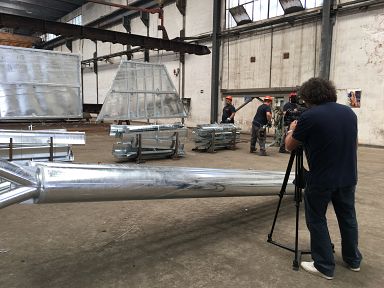The galvanizing business involves hot and arduous work, turning corroding steel into protected metal using baths of hydrochloric acid and molten zinc. It's also a business which EU researchers believe they can make cleaner and greener. Their tech is now facing, quite literally, the acid test.
The galvanizing business involves hot and arduous work, turning corroding steel into protected metal using baths of hydrochloric acid and molten zinc. It's also a business which EU researchers believe they can make cleaner and greener, with the latest membrane and dialysis technology.
The factory run by Sicilian firm Tecnozinco is one of their test grounds, where the goal is to find a new way to recondition and recycle the used acid from its plant. Steel is soaked in acid during galvanization, a process known as 'pickling'.
Acid overheads
Right now, treating the 300 tonnes of spent acid the plant produces every year is a financial and environmental cost that adds up to a significant overhead, as Technical Manager Alberto Di Cristofalo explains: "We are in Sicily. And the problem for us is that the treatment plants for waste solutions are located in northern Italy. So there is a very high cost of disposal because of the distance. Moreover, these large quantities create a considerable environmental impact, both for the quantities of acid that we have to buy and for the quantities of waste that have to be disposed of."
The answer may well be a new machine built by the EU's ReWaCEM project consortium. Installed at the plant in spring this year, it can recycle 20 to 40 litres of used acid per hour, and extract the valuable metals dissolved within it.
The man behind the machine is Daniel Winter, from Fraunhofer ISE in Germany, and he explains how it works: "These (acid) solutions are introduced into this innovative plant, which then extracts the various valuable components from the solutions, separates them into the acid, which can be re-used, which can be returned to the processes, and the salts, which can then be precipitated into a recyclable material, which can then be sold, and the wastewater no longer has to be disposed of, but is completely recycled."
Testing the membranes
Meanwhile, at the University of Palermo other scientists in the ReWaCEM project are working to improve the acid treatment system, which combines the latest dialysis and membrane technology to act as a kind of sieve or filter.
In theory, the membrane should stop positively charged ions of iron, zinc or copper in the acid from passing through. But they've found that isn't always the case, according to Post-Doctoral Research Assistant Alba Ruiz Aguirre: "In general they have a very good recovery in terms of acid, but if it is true that experimentally and in reality, yes, they don't always reject all of the salts."
Her colleague Serena Randazzo adds: "The membrane technology is very promising, the only disadvantage at the moment is the cost of the membranes. When you go on an industrial scale it is possible that this cost is reduced and, therefore, becomes very convenient economically."
Moving to industrial scale
The ReWaCEM project team's goal is to evaluate their technology at the demonstration sites and then take the innovation to industrial scale, as part of the general trend towards what's known as the 'circular economy'. Outstanding questions on this technology include the lifespan of the membranes, and whether the system will need dedicated staff to operate it.
A key selling point is that the technology can be applied in many areas, according to Daniel Winter: "The good thing about the technological approach is that it has a very high universality, i.e. it can not only be used at this location for exactly these solutions, but there are many industrial processes that have exactly similar problems that can be addressed with it, such as in stainless steel production, in circuit board production or also in electroplating, everywhere this process can be applied."
Tecnozinco will give its verdict soon on how the ReWaCEM machine performs, while two SMEs in the project, SolarSpring and Deukum are working on commercialising the system.












